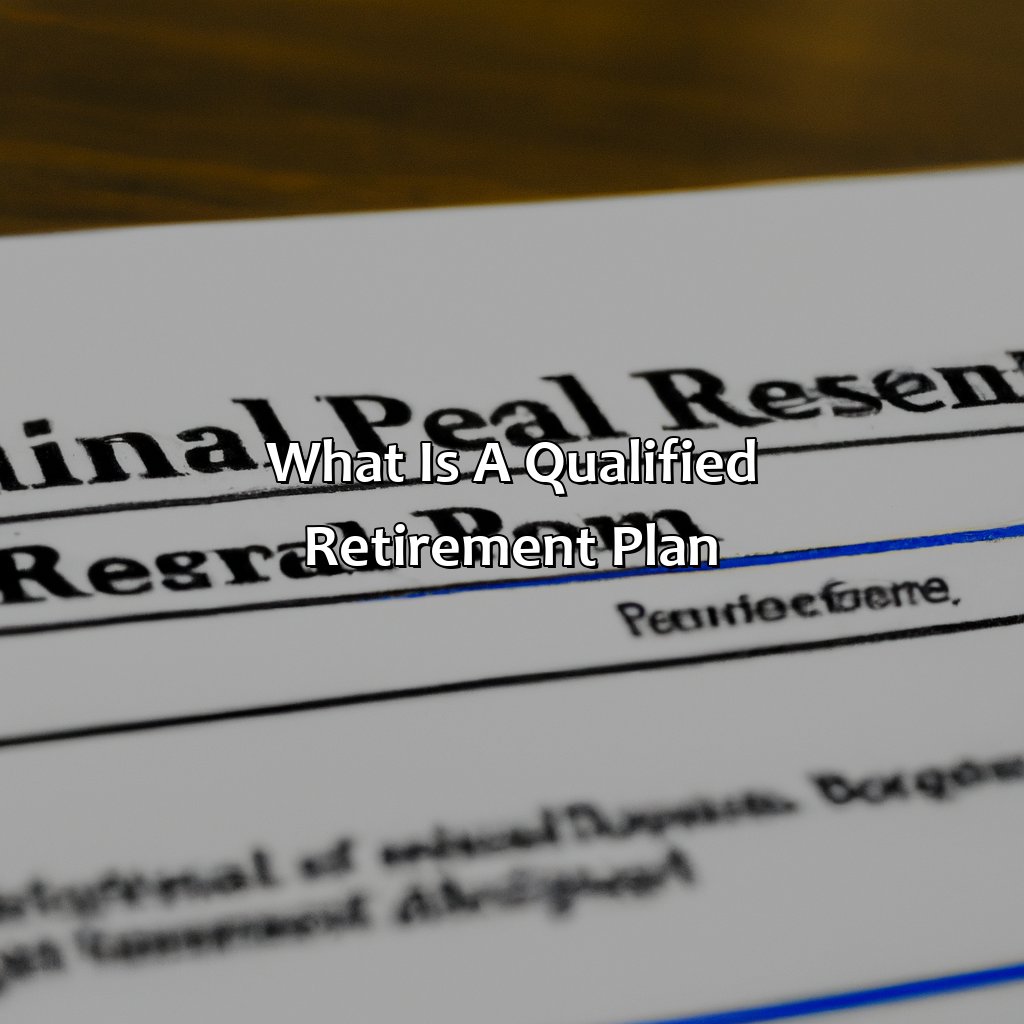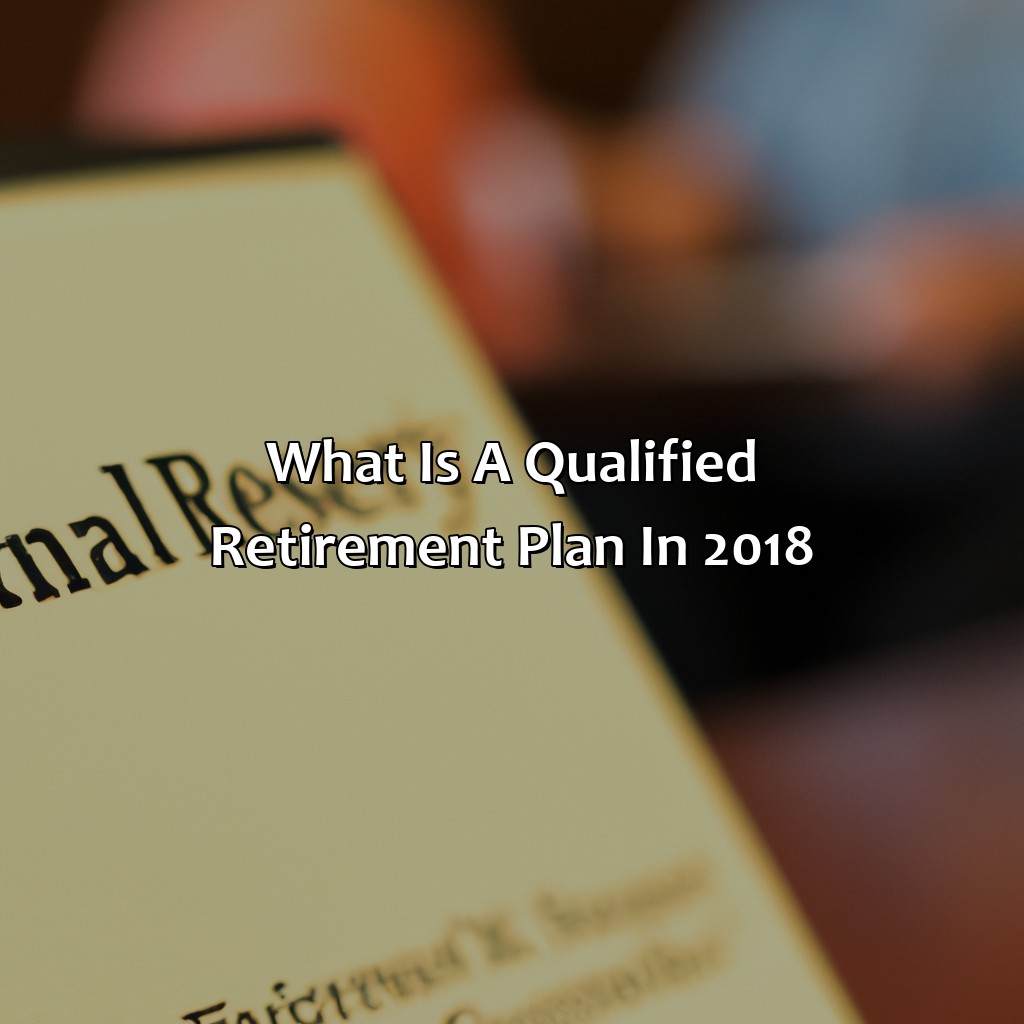What Is A Qualified Retirement Plan In 2018?
Key Takeaway:
- A qualified retirement plan is a savings plan that meets certain tax requirements set by the Internal Revenue Service (IRS). It allows individuals and employers to save money for retirement on a tax-deferred basis.
- There are four main types of qualified retirement plans, including defined benefit plans, defined contribution plans, profit-sharing plans, and 401(k) plans. Each plan has different rules and requirements, but they all offer tax benefits and the potential for employer contributions.
- Benefits of a qualified retirement plan include tax savings, the ability to save and invest for retirement, and potential employer contributions. Eligibility and participation requirements vary, but recent changes in 2018 have increased contribution limits and introduced new tax credits for small businesses offering retirement plans.
Are you wondering about retirement planning in 2018? Qualified Retirement Plans can offer you tax benefits and financial security for your retirement. You need to know what options are available to make the best decision for your future.
What is a qualified retirement plan?
Qualified Retirement Plans: A Comprehensive Guide
A qualified retirement plan is a retirement savings plan that adheres to certain federally mandated criteria in order to qualify for specific tax benefits. The Internal Revenue Service sets forth guidelines that must be followed by employers in order to establish and maintain these plans for their employees. A qualified retirement plan typically consists of contributions made through payroll deductions, with the ability to defer income taxes on the contributions and investment gains until withdrawal. Examples of these plans include 401(k) plans, profit-sharing plans, and defined benefit pensions.
When contributing to a qualified retirement plan, employees are essentially investing in their own futures while receiving tax benefits. Employers may also offer matching contributions, contributing a percentage of the employee’s contributions up to a certain limit, further incentivizing participation.
It is important to note that not all retirement plans are qualified. Non-qualified plans do not adhere to the same guidelines set forth by the IRS and do not offer the same tax benefits as a qualified plan. Employers may offer non-qualified plans to certain employees, such as executives, as a supplemental retirement benefit.
In order to ensure financial security in retirement, individuals should be proactive in contributing to a qualified retirement plan. Failure to do so may result in missing out on valuable tax benefits and the potential for a secure retirement.

Image credits: retiregenz.com by David Arnold
Types of qualified retirement plans
The different categories of retirement plans that meet the requirements set by the Internal Revenue Service (IRS) are known as qualified retirement plans in 2018. Here are some categories of qualified retirement plans and their features:
| Types of Qualified Retirement Plans | Features |
|---|---|
| 401(k) plan | Provides tax-advantaged retirement savings through employee salary deferral with match and profit-sharing contributions from employers. |
| 403(b) plan | Available to employees of educational institutions and non-profit organizations, and allows employees to defer some of their salary into a tax-deferred retirement account. |
| Profit-sharing plan | Allows employers to make discretionary contributions to employees’ retirement accounts, usually as a percentage of salary. |
| SIMPLE IRA | Allows small employers to set up a retirement plan that offers some tax benefits to both the employer and employee. |
| Defined benefit plan | Provides a set retirement benefit in the form of a specified monthly payment, usually based on salary and length of service. |
| Cash balance plan | A type of defined benefit plan that resembles a 401(k) plan, allowing employees to see what their retirement benefit will look like in terms of a lump sum. |
It’s important to note that some retirement plans may fall under more than one category. For example, a 401(k) plan can also be a profit-sharing plan. Additionally, the rules and regulations for each plan type may vary, so it’s important to consult with a financial advisor to determine which plan works best for an individual’s unique situation.
Pro Tip: Regularly review and update retirement plan contributions to ensure that retirement goals are being met.

Image credits: retiregenz.com by Joel Jones
Benefits of a qualified retirement plan
A qualified retirement plan is a program sponsored by an employer that enables employees to save for their retirement. Understanding the benefits of participating in such a plan is crucial. Here are some advantages of a qualified retirement plan:
- Tax-deferred contributions: The amount you invest in a qualified retirement plan is tax-deductible, meaning your current taxable income is reduced by the contribution amount. This can be beneficial as you will not be taxed on your contribution until you withdraw the funds.
- Employer contributions: Some qualified retirement plans offer employer contributions, also known as matching contributions. This means that for every dollar you contribute, your employer may make a matching contribution that can significantly boost your retirement savings.
- Investment options: Most qualified retirement plans offer a range of investment options that are managed by professionals. This enables you to diversify your investments and potentially earn higher returns.
- Lower taxable income in retirement: Because withdrawals from qualified retirement plans are subject to taxation, retirees with a significant portion of their retirement savings in such plans may have lower taxable incomes in retirement. This can result in paying lower taxes on Social Security benefits and potentially less tax on other sources of retirement income.
- Automatic savings: Many qualified retirement plans offer automatic contributions, which make it easy to save for your retirement. You can choose to have a percentage of your paycheck automatically invested, making it easy to save without thinking about it.
Pro Tip: It is never too early or too late to start saving for retirement. Consider enrolling in a qualified retirement plan as soon as possible and aim to contribute the maximum allowed to maximize your savings potential.

Image credits: retiregenz.com by James Washington
Eligibility and participation in a qualified retirement plan
Participating in a Retirement Plan: Who is Eligible?
Retirement plans have different requirements for eligibility which we will explain. Companies may provide coverage for their employees so they can have more benefits that go along with their salary. Every qualified retirement plan will be required to provide more information on eligibility requirements.
It’s not uncommon for an employer to require eligible employees to work full-time. In many cases, employees are eligible for participating in a qualified retirement plan after they have been employed for 1 year. Perhaps, there are other retirement account types that may require a longer period of employment or more hours per week.
Anecdote: Joseph worked in his new job for three months when he found out he was eligible to participate in a qualified retirement plan. Although short, his company offered a generous matching contribution for its 401(k) plan.

Image credits: retiregenz.com by Harry Jones
Recent changes to qualified retirement plans in 2018
Recent developments in qualified retirement plans in 2018 are worth understanding. Major changes include the shift towards more flexible plan design options, increased contribution limits for some plans and the addition of a new after-tax contribution feature. These changes can have a significant impact on the retirement planning options available to employees and employers alike.
As we delve deeper into the changes in qualified retirement plans in 2018, it is important to note the newly added after-tax contribution feature. Employers now have the option to allow employees to make after-tax contributions of up to $5,500 per year. This feature gives employees the opportunity to save more for retirement and potentially benefit from tax-free growth.
It is crucial to take note of all the upgrades in qualified retirement plans to save efficiently for the future. The new features like after-tax contributions and increased contribution limits provide a golden opportunity to contribute more towards retirement and make the most of the available benefits. Don’t miss out on securing your future and start taking advantage of these upgrades.

Image credits: retiregenz.com by Adam Jones
Some Facts About Qualified Retirement Plans in 2018:
- ✅ A qualified retirement plan is a tax-advantaged retirement savings plan that meets certain regulatory requirements set by the IRS. (Source: Investopedia)
- ✅ Examples of qualified retirement plans include 401(k)s, IRAs, and pension plans. (Source: The Balance)
- ✅ Qualified retirement plans provide tax benefits like deductible contributions and tax-deferred growth. (Source: Fidelity)
- ✅ Employees can contribute a certain amount of their salary to a qualified retirement plan, and employers may offer matching contributions up to a certain percentage. (Source: Forbes)
- ✅ Qualified retirement plans have contribution limits and withdrawal regulations to ensure they are used for retirement savings purposes only. (Source: IRS)
FAQs about What Is A Qualified Retirement Plan In 2018?
What is a qualified retirement plan in 2018?
A qualified retirement plan is a program sponsored by an employer that allows employees to save for their retirement while receiving tax benefits.
What are the different types of qualified retirement plans in 2018?
There are several types of qualified retirement plans including 401(k), 403(b), profit-sharing plan, money purchase plan, defined benefit plan, and employee stock ownership plan (ESOP).
Are all qualified retirement plans the same in 2018?
No, each type of qualified retirement plan has different features, benefits, and contribution limits. It is important to choose the right plan based on your needs and financial situation.
Who can participate in a qualified retirement plan in 2018?
Generally, all eligible employees of a company can participate in their employer-sponsored qualified retirement plan. However, some plans may have eligibility requirements such as a specific length of service or job title.
What are the advantages of a qualified retirement plan in 2018?
The advantages of a qualified retirement plan include tax benefits, employer matching contributions, and the ability to save for retirement on a tax-deferred basis. Additionally, some plans may offer investment options with low fees and diverse funds.
What happens if I leave my job with a qualified retirement plan in 2018?
If you leave your job with a qualified retirement plan, you have several options such as rolling over the funds into an IRA, leaving the funds in the plan, or taking a distribution. It is important to evaluate the pros and cons of each option and consult with a financial advisor before making a decision.







